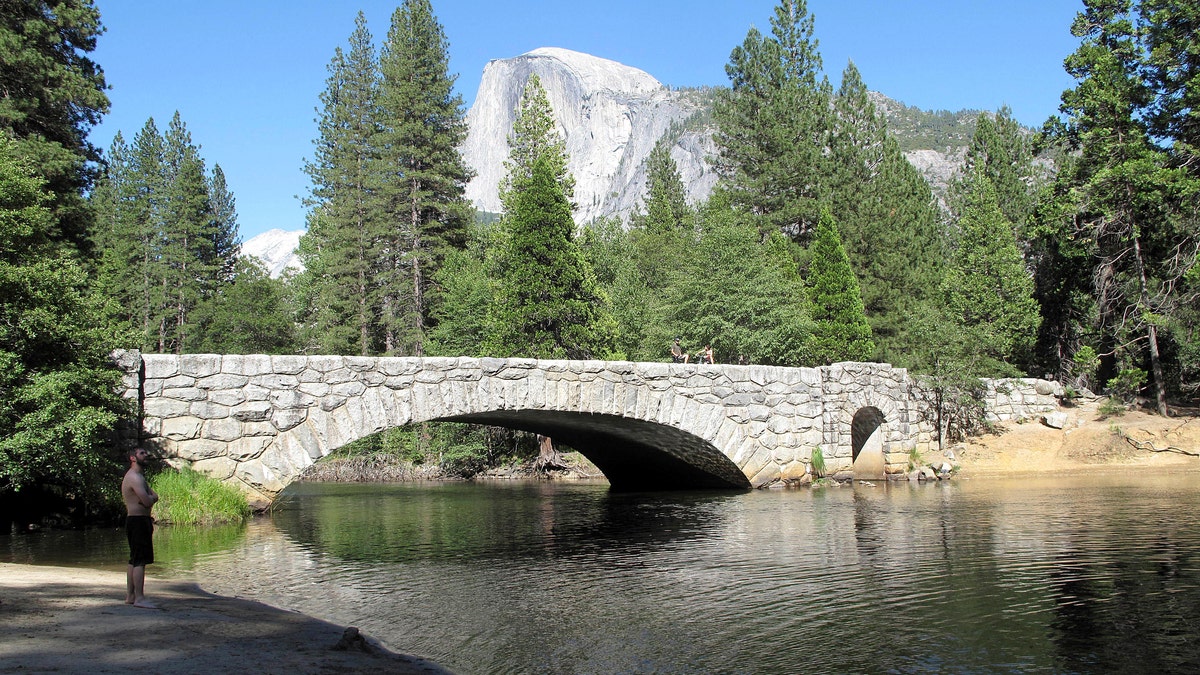
June 12, 2012: This photo shows Yosemite National Park's Stoneman Bridge, a single, arching span faced with rough-hewn granite, provides a dramatic foreground to Half Dome, the park's most iconic feature.
YOSEMITE NATIONAL PARK, Calif – Perhaps no river crossing in Yosemite Valley has been more photographed than the historic Stoneman Bridge: a single, arching span faced with rough-hewn granite that provides a dramatic foreground to Half Dome, the park's most iconic natural marvel.
Yet the 205-foot bridge is slated for possible removal under proposed plans for restoring the natural flow of the Merced River. As a federally designated "Wild and Scenic River," some say its course should be shaped only by nature as it meanders through the valley -- and bridge abutments alter that course.
The future of the roughly 80-year-old Stoneman and two other spandrel arch bridges has pitted environmentalists, who want the river to flow freely, against historic preservationists who say these early examples of the rustic park architectural style are too culturally important to destroy.
"We're talking about nationally significant resources in arguably the best-known national park in the world. What happens in Yosemite has echoes throughout the National Park System," said Anthony Veerkamp of the National Trust for Historic Preservation.
It's why last month the trust placed the Stoneman and two other Yosemite Valley stone-arch bridges threatened with removal -- the Ahwahnee Bridge and the Sugar Pine Bridge -- on its 2012 most endangered historic places list.
"These are not monumental structures -- they took their design cues from the environment," Veerkamp said. "I do not envy the very complicated decisions the National Park Service has to make."
Four other Yosemite Valley bridges cross the Merced River, but only these three are built into the river, said park spokesman Scott Gediman.
"Yosemite is known throughout the world for its beauty, but in addition to natural beauty, the cultural beauty is significant," Gediman said. "We take it very seriously. These are not decisions we're taking lightly."
Yosemite is remarkable among the nation's national parks with a combination of stunning beauty, inspiring hikes and proximity to populous metropolitan areas. Despite the park's 1,200 square miles of wilderness, 95 percent of the 4 million visitors each year stay in the one-by-eight-mile valley, where senses are overwhelmed by the Half Dome and El Capitan walls of granite, stands of pines and stair-step waterfalls.
Called the "Voice of Yosemite" by famed naturalist John Muir, the Merced River flows for 81 miles in the park, from its source 13,000 feet high in the Sierra-Nevada wilderness to its 317-foot drop into the tourist mecca and through it.
For more than 15 years, the park has been pressured by the courts and environmental groups to write a plan balancing public access against the strict protections that come with the river's 1987 federal wild and scenic designation. As the process winds down, options have included everything from limiting the number of daily park visitors, to slowing riverbank erosion by restricting access, to removing lodging and some camping areas in the valley and backcountry.
The wild and scenic designation left the park service leeway on how to protect the river, and Veerkamp said that protecting historic resources such as the bridges should have been recommended by the agency.
Instead, four of the five draft plans being considered by the park service include removing bridges to restore "free-flowing conditions" of the Merced. Two of those plans spare the highly trafficked Stoneman, where effects on the river are visible: Places where the bridge joins the shore are so eroded that archways built to allow horses to pass have become flooded with water
The 160-foot Ahwahnee, a triple span bridge, and the 170-foot Sugar Pine, a double, are listed for removal under all four plans because their abutments block water flow. From 1928 to 1970 they were part of a roadway from the Ahwahnee Hotel to Mirror Lake at the eastern end of the valley, but today are used only by hikers and bikers.
"It seems quite beautiful," said Christa Danielson of Eugene, Ore., as she sat on a log photographing the Ahwahnee Bridge. "It's amazing, but everything here is. It would be sad to see it go."
Park officials stress that none of the plans are final and they could be altered to spare all or some of the bridges. Until September, the public can register comments.
"When you have an historic structure in a wild and scenic river, in no way, shape or form are we saying that one is more important than the other, but we have to factor in everything," Gediman said.
The national trust says the bridges should never have been targeted for potential demolition, noting the federal Interagency Wild and Scenic Rivers Coordinating Council has deemed that low dams and "other minor structures" already in place at the time of designation shall not disqualify a wild and scenic river.
"The bridges have become a proxy war for those who want to keep the same level of visitor amenities and those who want to see reduced infrastructure," Veerkamp said. "They are treating them more as infrastructure rather than historic resources that need to be planned for for their own remarkable value."

